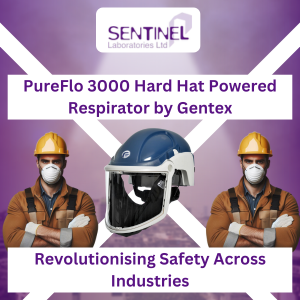To shave or not to shave..... when wearing a mask, is it even a question?
To shave or not to shave - that is the Question.
The Importance of Being Clean-Shaven When Wearing a Tight-Fitting Face Respirator: A Guide Based on HSE Regulations
In many industries, the use of tight-fitting face respirators is crucial for protecting workers from harmful airborne substances, including dust, fumes, gases, and vapours. To ensure that these respirators provide the necessary protection, it is essential that they fit correctly to form an effective seal against the wearer’s face. One critical aspect of achieving this seal is being clean-shaven. This blog post will explore why being clean-shaven is necessary when wearing tight-fitting face respirators, referencing the Health and Safety Executive (HSE) guidance and the importance of regular fit testing to maintain safety standards.
Understanding the Role of a Tight-Fitting Face Respirator
Tight-fitting face respirators, also known as filtering facepieces (FFPs) or elastomeric respirators, are designed to protect the wearer from inhaling hazardous airborne particles. These respirators work by creating a seal between the respirator and the skin, ensuring that air flows through the filter material rather than leaking in from the edges. If the seal is compromised, the respirator cannot provide the intended level of protection, potentially exposing the wearer to harmful substances.
The Impact of Facial Hair on a Respirator Seal
Facial hair, such as beards, stubble, or even heavy sideburns, can significantly affect the ability of a tight-fitting respirator to form a proper seal. According to the HSE's guidance document, "HSG53: Respiratory Protective Equipment at Work," facial hair that lies between the sealing surface of the facepiece and the skin will interfere with the fit of the respirator, leading to leakage and reduced protection (HSE, 2013).
The reason for this is simple: facial hair creates gaps between the respirator and the skin, allowing unfiltered air to enter the breathing zone. Even a small amount of stubble can prevent a tight seal, rendering the respirator ineffective. The HSE explicitly states that for tight-fitting respirators to work correctly, the wearer must be clean-shaven in the area where the respirator seals to the face.
The Importance of Fit Testing
Fit testing is a critical process that ensures a tight-fitting respirator can provide an adequate seal on the wearer's face. There are two main types of fit testing:
-
Qualitative Fit Testing (QLFT): This method relies on the wearer's subjective response to a test agent. It is typically used for half-face respirators and involves the wearer detecting a taste or smell of a test substance, indicating a poor fit.
-
Quantitative Fit Testing (QNFT): This method provides a numerical measure of the respirator’s fit by using specialized equipment to measure the amount of leakage into the respirator. It is more accurate than qualitative testing and is suitable for full-face respirators.
The HSE document "INDG479: Fit Testing of Respiratory Protective Equipment Facepieces" outlines the requirements for fit testing (HSE, 2019). It emphasizes that fit testing should be carried out before a worker uses a tight-fitting respirator for the first time and whenever there is a change in the type of respirator used or a significant change in the wearer’s facial characteristics.
The Need for Regular Re-Testing
Fit testing is not a one-time procedure. Regular re-testing is necessary to ensure that the respirator continues to provide adequate protection. The HSE recommends that fit testing should be repeated at least annually or more frequently if there are changes in the wearer’s facial features, such as:
- Weight Loss or Gain: Significant changes in body weight can alter the shape of the face, affecting the fit of the respirator.
- Dental Work: Changes to teeth or jaw structure, such as the addition or removal of dental appliances, can affect the fit.
- Facial Scars or Surgery: Any alteration to the facial structure, including scars from injury or surgery, can compromise the seal of the respirator.
- Changes in Facial Hair: Even if the wearer shaves regularly, changes in shaving habits or the growth of new facial hair can impact the fit.
The Consequences of Poor Fit and Inadequate Testing
The consequences of a poorly fitting respirator can be severe. Workers may be exposed to hazardous substances without realizing it, leading to serious health risks such as respiratory diseases, lung cancer, or occupational asthma. The HSE highlights that employers are legally responsible for ensuring that workers are adequately protected when using respiratory protective equipment (RPE). Failure to do so can result in legal action, fines, and harm to workers' health.
The Legal Requirement for Employers
In the UK, the Control of Substances Hazardous to Health (COSHH) Regulations 2002 require employers to provide suitable RPE when exposure to hazardous substances cannot be adequately controlled by other means. The HSE's "HSG53" guidance also emphasizes that employers must ensure that tight-fitting respirators are fit-tested on all employees who are required to wear them.
Employers must also ensure that workers understand the importance of being clean-shaven when wearing tight-fitting respirators and that they comply with this requirement. This responsibility includes providing training on the correct use of RPE and the consequences of not following safety protocols.
Conclusion
Being clean-shaven is not just a matter of appearance when it comes to wearing tight-fitting face respirators—it is a critical safety measure that ensures the respirator can provide the necessary protection. The HSE’s guidance makes it clear that facial hair can compromise the fit and effectiveness of tight-fitting respirators, putting workers at risk of exposure to harmful substances.
Employers must prioritize regular fit testing and ensure that all workers are aware of the importance of being clean-shaven in areas where the respirator seals to the face. By adhering to the HSE's guidelines, employers can help protect their workforce from occupational hazards and comply with legal obligations under COSHH regulations.
For further information, employers and safety officers should consult the HSE guidance documents "HSG53: Respiratory Protective Equipment at Work" and "INDG479: Fit Testing of Respiratory Protective Equipment Facepieces" to ensure they are fully informed of the requirements and best practices for RPE use in the workplace. Regular re-testing, awareness of the impact of facial changes, and a commitment to safety can make all the difference in maintaining a safe and healthy working environment.
References
- HSE. (2013). HSG53: Respiratory Protective Equipment at Work.
- HSE. (2019). INDG479: Fit Testing of Respiratory Protective Equipment Facepieces.





Leave a comment